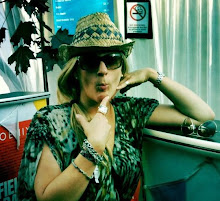As I sit here procrastinating about how to start this week's post all I can think about is a line from the Simpsons spoof episode of Crocodile Dundee. Bart exclaims in utter bewilderment to an Aussie bushman "that's not a knife, that's a spoon" after the Aussie boasts by saying "you call that a knife?, this is a knife". (I know two people who will laugh at that, but I think only one of them reads my blog.) Anyway, even during the wooden spoon carving class I did last weekend, I was thinking about the same thing. It was probably because I was struggling so much and I needed some light-heartedness to take me away from the stress.
Now don't get me wrong - this is a really lovely class to do with
Grain and Knot and super relaxing if you are good with your hands and good with tools. But, over the course of this year, I have realised that I am not!
But at the time I didn't think about that I just thought how nice it would be to carve my own wooden spoon. I think I'm a bit drawn to and sold on nice things to hold and touch. Its something "feely", which I love.
The class was at the
Town Hall Hotel in Bethnal Green and was combined with a 2-course lunch (following all our hard work of scraping, carving and for me, sweating profusely). I arrived to find everything laid out; tools, the timber pieces we would be carving and some "here's what I made earlier" spoons. It all looked rather pretty.
Our teacher, Sophie, who owns
Grain and Knot took us through everything, beginning by talking about the wood we would be carving. Everything she uses is reclaimed timber and mostly off-cuts from carpentry that would otherwise go in the bin. The woods on offer today were walnut or beach. Sophie mentioned that walnut is a little harder to carve, so to keep my anxiety levels at a minimum I chose beach. The two tools we would use to carve our spoons are a Swedish hook knife and a straight knife. Then the first thing to do, was mark out the basic shape of our spoon on the wood.
The process of the carving begins with the Swedish hook knife and scooping out the middle of the spoon. The knife has blades on each side and so it has to be held in a specific way to minimise risk of accidents. Sophie showed us how to use and hold the knife in order to get the most effective scoops and scrapes out of the wood.
Unfortunately, it is not the most natural of ways to hold and use a tool like this and so it did take a while for people to get the hang of it. Sadly for me, I could feel the stress levels rising while truing to do this and my palms just got sweatier and sweatier so I couldn't hold the knife in he right way. I found it so hard to carve ribbons out the spoon and to get any depth out of the wood, plus my hands were slipping, hurting and aching. But, Sophie helped me a lot and gave me a lot of attention, while was really good. Her classes are always around six people and so she is able to offer help to everyone.
After scooping out enough of the spoon middle with the hook knife, we moved onto the handle using the straight knife. This was a lot easier, just fairly time-consuming. Again, I'm not going to lie, Sophie did help me out a lot but I still got on and did it.
A couple of hours flew by and a lot of wood shavings mounted up, but we had to finish there and clear everything away for our lovely lunch. Everybody had done a really good job and it certainly felt very satisfying to have something hand-carved at the end. We also had plenty of blisters on our hands; not so satisfying. Sophie gave us each a little wooden tube to put our spoons in, as well as some sandpaper and coconut oil to finish and protect them.
If you're someone that likes making things and using intricate tools then definitely try this little art form . Its wonderful. It just wasn't quite right for me, but so glad I tried it.



















0 Comments:
Post a Comment